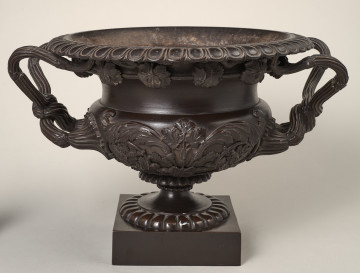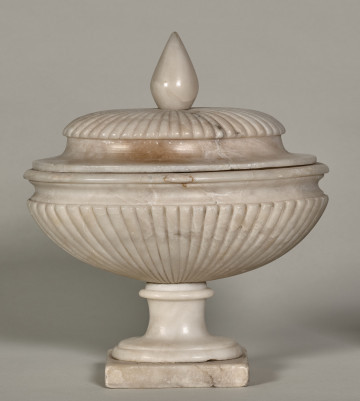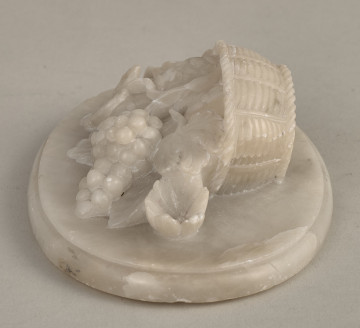
Vase
19th / 20th century
Castle Museum in Łańcut
Part of the collection: Rzeźby
Decorative vase This alabaster vase was made by an unknown sculptor in Italy at the turn of the 18th and 19th centuries. Its ovoid bowl is decorated with a semi-plastic decorative motif depicting four pigeons standing on the rim of the bowl, one of them drinking water from it. This decorative motif, popular in the Neoclassicism period, was based on an ancient Roman mosaic made in the 2nd century according to an original from the first half of the 2nd century BC – a work by Sosos, a prominent Hellenistic artist working in Pergamum. The Roman mosaic was found in 1737 in Hadrian’s villa in Tivoli and is now kept in the collection of Musei Capitolini in Rome. The vase is one of a dozen or so decorative marble and alabaster vases adorning the Sculpture Gallery, i.e. a room established after 1792 on the initiative of Princess Izabela Lubomirska (1753–1816), owner of the Łańcut castle. The walls and ceiling of the Gallery are covered with an illusionist painting showing the interior of an ancient ruin covered with a trellis entwined with grapevine. The exhibition set up there include ancient and modern marble and alabaster sculptures such as statues, busts and vases acquired by the owners of the castle in the fourth quarter of the 18th century and in the 19th century, mainly in Italy. The exhibition of vases is worth mentioning. They stand in niches hollowed in the wall of the ruin and on rock blocks protruding from the wall. Barbara Trojnar
Author / creator
Dimensions
height: 27 cm
Object type
Sculptures
Technique
cast
Material
alabaster
Origin / acquisition method
decyzja administracyjna
Creation time / dating
Creation / finding place
Owner
Castle Museum in Łańcut
Identification number
Location / status

19th / 20th century
Castle Museum in Łańcut

1800 — 1899
Castle Museum in Łańcut

19th / 20th century
Castle Museum in Łańcut
DISCOVER this TOPIC
Castle Museum in Łańcut
DISCOVER this PATH
Educational path